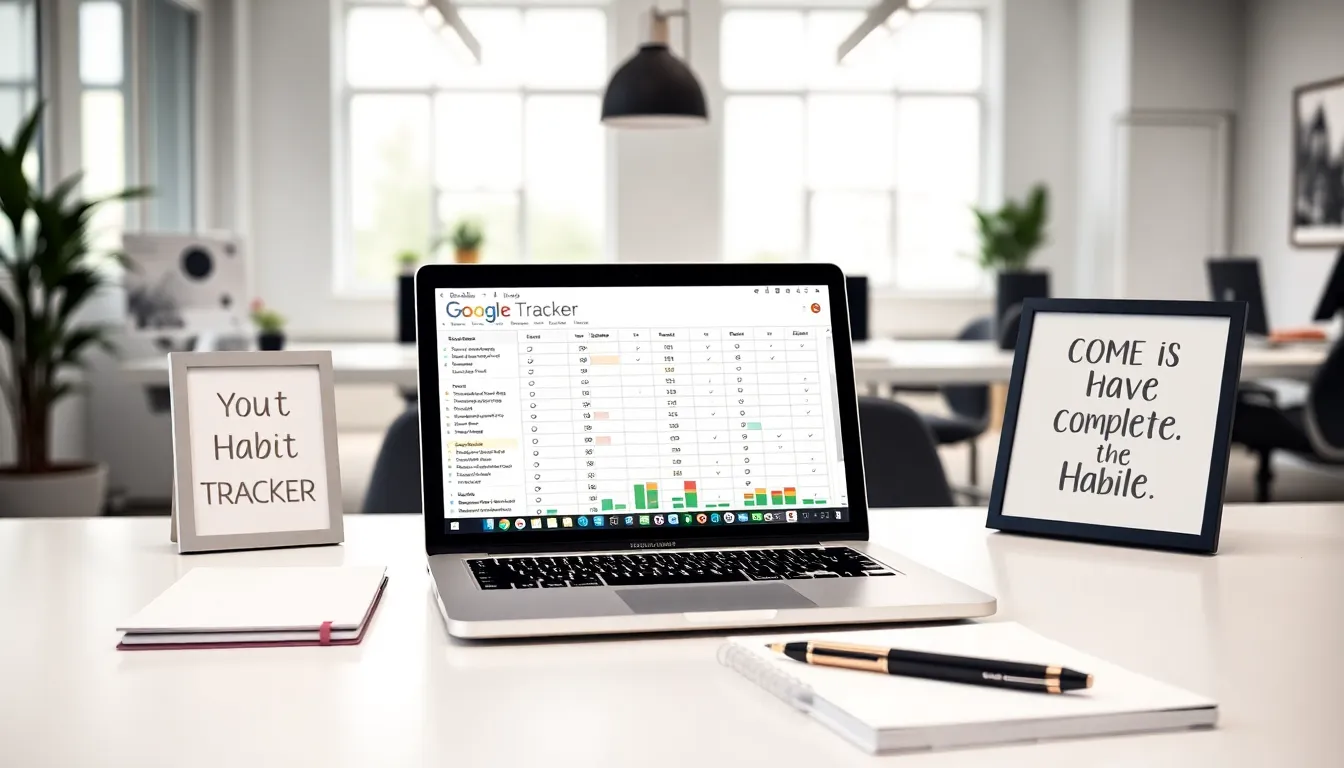Table of Contents
ToggleEver felt like forming new habits is as tough as teaching a cat to fetch? You’re definitely not alone. Keeping track of habits can feel overwhelming, but with the magic of Google Sheets, it doesn’t have to be. A Google Sheets habit tracker can transform your daily chaos into neatly organized data, helping you stay on top of your game. From working out to reading more, tracking your habits allows you to see your progress and adapt as needed, all with a dash of fun. Let’s jump into why a habit tracker is a must-have and how Google Sheets can make this journey smoother.
Why Use a Habit Tracker?

Being successful doesn’t happen by accident, and using a habit tracker is a smart solution for intentional growth.
Benefits of Tracking Habits
Tracking habits comes with a range of benefits that are hard to ignore. For starters, it provides clarity. By regularly monitoring actions and behaviors, individuals can identify what works and what doesn’t. This kind of data can lead to better decision-making in everyday life. Plus, visualizing progress can lead to a sense of accomplishment that forms a positive feedback loop, reinforcing these behaviors.
Another notable benefit is accountability. When someone tracks their habits, they are more likely to stay committed. Just knowing that one is recording daily activities can inspire them to stick with their plans. And let’s not forget about the satisfaction that comes with checking off completed tasks: it’s like giving yourself a little dance party, one checkmark at a time.
Psychological Effects of Habit Tracking
The psychological aspects of habit tracking are fascinating, to say the least. Research indicates that seeing one’s progress can trigger feelings of pride and motivate individuals to strive for even more. In fact, it’s not just about the end goals. The act of tracking can release dopamine, the feel-good hormone, resulting in greater productivity and a happier mindset along the way. When people see their hard work visually represented, it motivates them to keep pushing forward. Who wouldn’t want to keep that momentum going?
So why not leverage these psychological benefits? A habit tracker offers a practical way to orchestrate personal growth while harnessing the power of positive reinforcement.
How Google Sheets Enhances Habit Tracking
When it comes to habit tracking, Google Sheets shines as a flexible tool. Its user-friendly interface allows anyone to create their own tailored templates without any special training. Whether you’re a tech enthusiast or someone who just learned to open an email, Google Sheets makes the process accessible.
Not only can users input their habits, but they can also use color coding to signify progress, share their tracker with friends for accountability, or access it from any device. This accessibility means one can check in from anywhere, be it on a coffee break or during a commute, making habit tracking seamlessly integrated into daily life.
Also, Google Sheets comes with built-in functions and formulas that can further enhance the tracking experience. Automatic calculations for success rates or trends over time make it easier to analyze habits without sifting through mountains of data. Truly, Google Sheets empowers users in ways that static paper trackers simply can’t.
Setting Up Your Habit Tracker in Google Sheets
Creating a habit tracker in Google Sheets is as simple as pie, and here’s your step-by-step guide.
Step-by-Step Guide to Creating a Habit Tracker
- Open Google Sheets: First things first, head over to Google Sheets and create a new document.
- Set Up Columns: Start with columns for the days of the week, your habits, and a spot for notes. You can title each column as conveniently as you’d like, maybe even include a fun emoji to brighten things up.
- Input Your Habits: List the habits you wish to track. Whether it’s drinking more water or hitting the gym, make sure to jot them down in the left column.
- Track Your Progress: As you complete each habit, use checkmarks, or fill cells with colors to express your success.
- Visual Aids: Consider adding graphs or charts to visualize your data. They can show trends over time and keep you motivated.
Customizing Your Tracker for Personal Use
One of the key benefits of Google Sheets is customization. Adjust your tracker by incorporating filters for specific months or years. Add motivational quotes or even images that inspire you. The sky’s the limit. Do you have a specific color scheme? Use it. Want to change the layout entirely? Go for it. Making the tracker uniquely yours can make the experience not only practical but also personal.
Using Formulas to Automate Tracking
Formulas can elevate your Google Sheets habit tracker from basic to brilliant. They allow for automation, turning tedious tasks into a breeze. For instance, a simple formula can calculate completion rates automatically.
To set up a basic formula:
- Input a formula like
=COUNTA(A2:A31)to count the numbers of entries for a month. - Use
=COUNTIF(B2:B31, "Yes")to count how many times you’ve completed a specific habit.
These small automations can save time and provide insights that enhance understanding of habits. As you get comfortable with formulas, explore more complex functions. For instance, creating rolling averages can highlight strengths and weaknesses over time.
Essentially, using formulas can transform your tracker into a powerful analytical tool, making your habit formation journey even smoother.
Types of Habits to Track
Now comes the fun part, deciding what habits to actually track. The options are nearly limitless, and the choice can depend largely on individual goals.
Tips for Successful Habit Tracking
Start with a few habits rather than overwhelming oneself. Identify a mix of short-term goals and long-term transformations. Maybe track health habits like drinking enough water, physical activity, or mindfulness practices like meditation. Consider also tracking productivity habits such as reading or time spent on social media to help manage usage effectively.
Another smart approach is to categorize habits into daily, weekly, and monthly. This can offer a balanced perspective and help ensure that one is focusing on a comprehensive range of goals.
Reviewing and Adjusting Your Habits
Don’t be afraid to revisit and modify your tracker. If something isn’t working, tweak it. The beauty of a digital tracker is the ability to change categories, colors, or methods of tracking whenever necessary. Regular reviews can lead to meaningful insights and ensure that tracking remains relevant to current goals.





